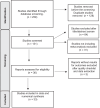Risk and Protective Factors of Self-harm and Suicidality in Adolescents: An Umbrella Review with Meta-Analysis
- PMID: 38564099
- PMCID: PMC11045640
- DOI: 10.1007/s10964-024-01969-w
Risk and Protective Factors of Self-harm and Suicidality in Adolescents: An Umbrella Review with Meta-Analysis
Abstract
Suicide remains the second most common cause of death in young people aged 10-24 years and is a growing concern globally. The literature reports a vast number of factors that can predispose an adolescent to suicidality at an individual, relational, community, or societal level. There is limited high-level research identifying and understanding these risk and protective factors of adolescent suicidality. The present study used an umbrella review and meta-analysis to synthesize evidence from the review literature in the past 20 years on risk and protective factors of self-harm and suicidality (behavior and ideation) in adolescents. The umbrella review included 33 quantitative reviews with 1149 individual studies on suicidality and self-harm. Based on the data synthesis, it compared the public health impact of exposure on the population of the identified exposure. Bullying victimization was the most attributed environmental exposure for suicidality. The other identified significant school and individual factors were sleeping disturbance, school absenteeism, and exposure to antidepressants. Several significant vulnerable young populations were identified with significantly higher prevalence of suicidality, including lesbian, gay, bisexual, transgender, queer (or questioning) youth and those with mental health disorders, problem behaviors, previous suicidality, self-harm, and gender (female). A person-centered approach emphasizing connectedness and bully-free school environments should be a priority focus for schools, health professionals, and public health policymakers.
Keywords: Bully victimization; Meta-analysis; Risk and Protective factors of non-suicidal self-harm; Risk and Protective factors of suicidality; Sleep disturbance; Umbrella review; Vulnerable adolescent.
© 2024. The Author(s).
Conflict of interest statement
The review complies with international ethical standards in reviewing research studies. The authors declare no competing interests.
Figures
References
-
- *Refers to reviewed articles.
-
- AAP. (2022). Risk factors, Protective factors, Warning Signs of Youth Suicide. American Academy of Pediatrics. https://www.aap.org/en/patient-care/blueprint-for-youth-suicide-preventi....
-
- Aromataris E, et al. Summarizing systematic reviews: methodological development, conduct and reporting of an umbrella review approach. JBI Evidence Implementation. 2015;13(3):132–140. - PubMed
Publication types
MeSH terms
LinkOut - more resources
Full Text Sources
Medical
Miscellaneous




